In Israel, when Purim falls on a Friday and Shushan Purim on Shabbat, the Jerusalem rituals are spread out over Friday and Sunday instead of celebrating on Saturday. This is called a Purim Meshulash, a triple Purim. I spent this three-day Purim this year sleeping on the street in Tel Aviv with families of the 59 hostages still being held captive by Hamas in Gaza. I know Purim is supposed to be a joyous holiday, but I could not force myself to go about business as usual this year.
On Thursday night, my spouse Jacob and I camped out next to the Defense Department building on Begin Street, where there had been an encampment since the preceding Saturday night. We showed up with our tent, camping pads and sleeping bags, and we set up camp with the others.
It was a moving experience to be there in these very difficult times with so many concerned citizens, in peaceful protest against the government’s dragging its feet over bringing the rest of the hostages home. Netanyahu clearly values his political survival over the fates of the hostages and what is best for this country.
Begin Gate is a major street in the middle of Tel Aviv, so it was not a peaceful camping experience. I didn’t sleep much, and the morning view was the buildings across the street. But it was inspiring. I wouldn’t have wanted to be anywhere else. At 7 a.m., there was the daily encampment bike ride of seven times around the building (we noticed that Yehuda Cohen, hostage Nimrod Cohen’s father, was one of the riders) calling out “All of Them — NOW!” while riding.
At 8 a.m., there was the morning jog around the building. Einav Zangauker, the “lioness” mother of hostage Matan Zangauker and of the ongoing protests at Begin Gate, gave a pep talk between the two events. Jacob did the run. They distributed signs on sticks with pictures of the hostages still in Gaza. Jacob ran with a photo of Hadar Goldin, z”l, whose body has been help captive for the past 10 years in Gaza. He was a soldier when he was killed. I, who live with muscular dystrophy and can’t run, sat, holding a sign that read in both Hebrew and Arabic “Until the Last Hostage!” with others. One woman dressed in a sad clown costume was most appropriate for this year. We lined this major thoroughfare as vehicles honked their support as they passed. It was especially moving when the bus drivers honked their very deep and loud horns.
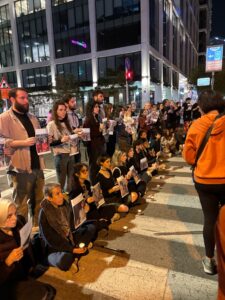
At 10:30 a.m., there was a Megillah reading at Hostages Square, which is a 10-minute walk from Begin Gate, on the other side of the Defense Department building. Like last year, the reading was organized by my kibbutz, Hannaton. It was surreal to be at the square again for Purim, doing the same thing. In 2024, I definitely did not think there would be 59 hostages still in Gaza a year later. One of the readers was Chen Avigdori, whose wife and daughter were hostages in Gaza and came back in the first hostage-ceasefire agreement, and whose nephew Tal Shoham just came back in the current agreement. Many of their relatives were killed or taken hostage on Oct. 7 in Kibbutz Be’eri. Chen offered a prayer: that those who have the power to bring about a hostage-ceasefire agreement that includes all the hostages at once, put aside all political considerations and do so now, before it is too late.
I received three helpful messages from speakers at the reading.
- Before reading the ninth chapter of the Megillah, when the Jews go to war against the Persian people who had planned to kill them, another friend from my kibbutz, Rabbi Shira Levine, asked us to pause and take a moment to think about the difference between acting in such a situation from a place of revenge or from a place of self-defense. That was, of course, a pertinant question for our times.
- After the reading, Hannaton kibbutz member, Elisheva Barak, who has been organizing daily prayer services at Hostages Square as part of her job at the Masorti movement (the Israeli equivalent of the Conservative movement), pointed out that in the Megillah, the massacre of the Jews that was supposed to happen on Purim did not because Mordechai and Esther saw the signs and prevented it. They acted responsibly and bravely for the good of the whole nation — unlike Israel’s government leading up to Oct. 7. She added that in the last verse of the Megillah, we are told that Mordechai strove for peace for his people. Also unlike Israel’s current government, which has no plan for peace moving forward and, in fact, was and is doing all it can to prevent peace with the Palestinians.
- Rabbi Ayala Dekel then spoke about the Torah portion, when Moses breaks the tablets. She pointed out that Moses then fashions new tablets out of the broken ones. She offered a prayer: May our society be able to do the same — heal and fashion a new and better reality out of this broken one. I thought of all the people camping out around the corner, and all the people who keep Hostages Square going, and I felt in my bones that this vision is actually possible.
After the reading, the parents of Hadar Goldin addressed those present. When his mother spoke, I cried. Imagine waiting this long to be able to bury your son. She read something Hadar himself had written when he was 15 years old and a counselor in his B’nai Akiva youth movement. The line that stood out most for me, especially having been in the encampment just before, was that we should strive to be the writers of our own life stories and not let others write them for us. Hadar’s father then added that if more people followed their son’s advice to be active and not passive members of society, then the hostages would all be home by now. Hadar grew up in the religious Zionist community. A friend of the family spoke as well, saying that the religious Zionist parties in the government should have been threatening to topple the government if a hostage agreement was not signed. Instead, they have been doing the opposite. This is disgraceful.
We arrived home a bit before Shabbat, and I headed out, as I do every Friday afternoon, to protest in front of my neighbor Amichai Chikli’s house. Amichai is Minister of Diaspora Affairs in this catastrophic government. I disagree with most of what he says and does as a member of this government, but most notably, now is his vote against the first stage of the hostage-ceasefire agreement. He says he will do the same with the second, even after families of the hostages have beseeched him to support it.
One sign hanging on a tent read: “I have no relative who is a hostage in Gaza, and I am here. What about you?”
On Saturday night, Jacob and I returned to the encampment. We were at the big weekly Saturday-night demonstration next to the encampment, at Begin Gate, where there were tens of thousands of people, many more than have been in the past weeks — first marching from Habima Square to Begin Gate, and then demonstrating loudly and emphatically there. A smaller number remained to sleep over in the encampment. It was a diverse group, with conversations going on into the early hours of the morning. I saw men with black kippot in deep conversation with long-haired men with no kippot. And people were up with the sun to bike and run around the Defense Department building and sit with signs in view of those in the vehicles passing by. Some also prayed the morning tefillot with tallit and tefillin.
Jacob and I were not sure if we would stay over again, but we had brought our camping equipment along just in case. At 11 p.m., we decided to stay the night. Why? Because that is where I find the hope for this place and for the world in general, in people who care and show up. As one sign hanging on a tent read: “I have no relative who is a hostage in Gaza, and I am here. What about you?”
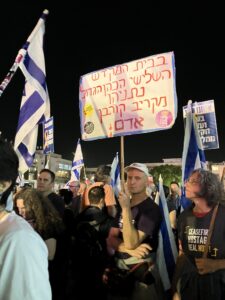
I am a very active member in an Arab and Jewish partnership grassroots national movement called Standing Together, especially in my local Nazareth-Jezreel Valley circle. The Tel Aviv circle was handing out an Israeli version of a “Bazooka Jo” comic to the effect of: “Why do you continue to protest when it seems the government doesn’t care about us?” Answer: “Well, at least WE care about us!”
We came home from Tel Aviv on Sunday, and by Tuesday, we were heading back. We awoke Tuesday morning to news Israel had attacked Hamas during the night, killing some Hamas terrorists but also killing hundreds of people and ending the ceasefire. This could likely mean the deaths of the remaining hostages, too. Already the week before, when Israeli Prime Minister Benjamin Netanyahu announced he was beginning the process of firing Attorney General Gali Baharav-Miara, plans were forming for huge protests in Jerusalem on Monday, March 24. But Sunday night, he announced he was firing the head of the Shabak (Israel Security Agency), too. So the date to kick off the major Jerusalem protests was moved up. Then, there was Tuesday’s air attack of Gaza, a sign of Netanyahu choosing his own political survival over that of the hostages. This is unforgivable. So Jacob and I headed back to Tel Aviv to a big emergency protest at HaBima Square. It was attended by nearly 50,000 people. At the beseeching of Einav Zengauker, mother of hostage Matan, we then marched to Begin Gate. We remained at Begin Gate until 11 p.m. The protest was still going strong. We headed to an encampment at Moza, seven kilometers from Jerusalem. There we ate leftovers from the protesters-campers’ dinner while sitting around a campfire planning the march into Jerusalem planned for the following morning.
I slept better that night than I had on the streets of Tel Aviv. It was much colder here, but at least we were on grass and not asphalt. And the view of the Jerusalem Hills spotted with almond blossoms was a welcome alternative to the Tel Aviv skyscrapers. The march up the mountain into Jerusalem with thousands of others was energizing and gave me hope. As one bereaved mother (whose soldier son was killed on Oct. 7 defending the kibbutzim of the Gaza Envelope) who spoke during the march said: “There are still citizens who care, who are willing to fight for the character of this country, for democracy and for the ethics on which we were raised and on which I raised my son.” When we reached the “Chords Bridge” at the entrance to the city, we sat on the highway and sang the words of Rabbi Nachman from Breslov: “All the world is a narrow bridge, but the most important thing is not to be afraid.” It was a powerful moment that prepared us for the day of continuing protests ahead. There were protests at different locations around the city with different focuses.
We won’t go quietly into dictatorship and the moral erosion of our society.
We were around 100,000 demonstrators in front of the government offices compound, in a comprehensive protest against Netanyahu and his most recent actions — firing anyone who dares to contradict or question him; endangering the country and its citizens to preserve his extreme right-wing coalition and his political survival; restarting the war at the expense of the remaining hostages; refusing an investigation into the debacle of Oct. 7; having people working in his office who were also working for Qatar; and more. We then marched to the Prime Minister’s residence on Gaza Street, where the protest became more heated and there were arrests and police violence. Meanwhile, there was a sit-in of thousands in white in Sacher Garden, focused on the hostages, and then a protest focused on protesting the resumption of the war, in Paris Square in front of the Knesset. A fellow Standing Together activist there was hit by a car, apparently intentionally. It dragged him some 50 meters and left him with a broken leg. The driver, it seems, was acting in counter-protest.
Jacob and I left that night, as I had a surgical procedure scheduled for the next morning, and we both had work and family commitments. And on Friday, I had another protest planned for in the Arab city of Sachnin, against the epidemic of organized crime killings in the Arab Israeli society here, especially in my area (the Lower Galilee), in which it has been escalating even more due to the neglect of this current government.
On the way to the bus stop in Jerusalem to get back to our car, which we had left in Moza, two young men wearing black suits and black kippot saw Jacob carrying an Israeli flag (the symbol of the anti-government protest movement) and our T-shirts from the Hostages Families Forum, and told us to go back to Tel Aviv. Then, while we were waiting for the bus, another young man, wearing a knitted kippah that indicated that he belongs to the Breslov Hassidim, told Jacob that it would be better for him not to wear a kippah at all rather than his rainbow kippah.
“What?!” I said, aghast. He repeated what he said. The moment was saved when a woman in a gray skirt and sweater and a sheitel (a wig to cover her natural hair, for modesty’s sake, indicating her belonging to the ultra-Orthodox community) told him that he should be ashamed of himself for saying such a thing. As she ran for her bus, I called out a sincerely felt “Thank you!” This woman prevented me from falling into despair, as did seeing the protest movement regaining momentum.
Earlier, while we were waiting for the march into Jerusalem to begin, I saw the back of the sweatshirt (of the Brothers in Arms movement of the demonstrations) of Member of Knesset (of the Democratim party of the opposition) Rabbi Gilad Kariv wearing read: “Hope Dies Last.” In fact, after I saw him wearing it, I bought myself that very sweatshirt at the same table he probably had moments before.
We won’t go quietly into dictatorship and the moral erosion of our society. Where there is struggle, there is hope.
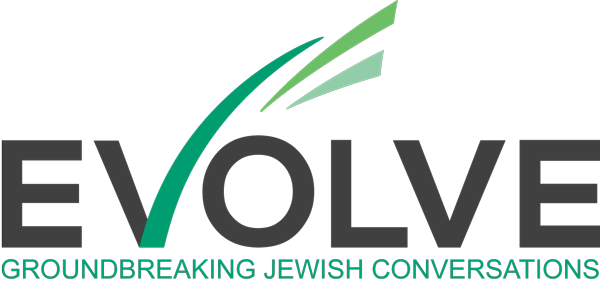
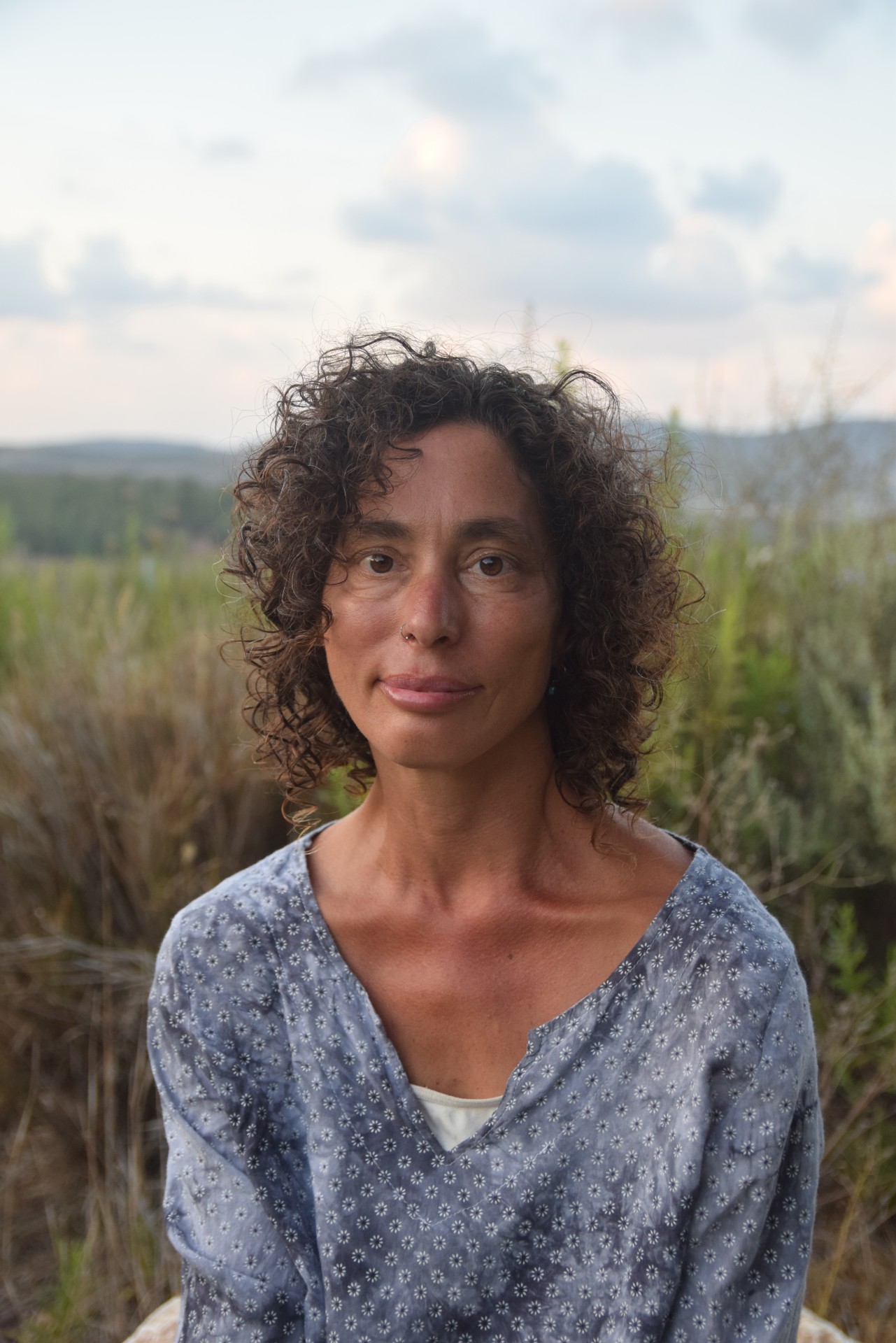





One Response
An excellent description of what is happening in our society. And, Haviva takes a prominent part in keeping our country in check
If it were not for the numerous protests, Bibi would do anything to promote his political agenda and survival over returning the hostages, which has always been the mantra of our countrymen and religious parties. Today, people aren’t working for these values The religious parties are working in a way contrary to religious beliefs. All this in order to stay in the government and continue to receive mounds of money for their respective communities. An unbelievable betrayal of Jewish religious values. The entire country is being headed in the direction of a dictatorship. Bibi, like Trump is trying to neuter the judiciary in order to consolidate power in their hands. Instead of leading us to be a light unto nations, BIBI is copycatting and imitating Trump’s behavior. As Oscar Wilde once proclaimed: “Imitation is the sincerest form of flattery .” And Bibi is just not flattering Trump because he is afraid to topple his announcements., but he is sheepishly following Trump’s every move to becoming a dictator. Our countrymen, Israel, deserves better. And, if not for Haviva and Jacob and thousands others who protest, there will be no hope to change matters. We owe a huge debt to all the wonderful people who are protesting every one of Bibi’s moves